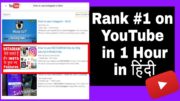I’ll admit it – I avoided YouTube and video SEO for about as long as I could. This year it became overly apparent that I could no longer do so and I have to acknowledge YouTube and video for what it is – an SEO superpower.
Once I moved past my avoidance, I dug into video SEO and learned as much as I could about it. You know what I discovered? It’s a lot like regular SEO. Keyword research, quality content, usability, and engagement all matter and they matter a lot.
Just like a regular search engine, YouTube has a specific set of data calculations it runs through to decide what videos will be displayed in search and what ranking they will have when listed.
The major data points in YouTube for video SEO include:
Freshness and frequency of channel – Post videos often so your channel is fresh and has new content for visitors.
Click through rates – Optimize titles to maximize click through rates from results pages.
Channel authority – Work on and off-site to build your authority on YouTube. The greater authority you have, the great change you have to rank.
Channel subscribers – Work at building a strong subscriber base. YouTube views subscribers as votes for quality, so encourage people within YouTube and outside of YouTube to subscribe.
Video content
Title – Include your keyword phrase and limit titles to 100 characters.
Description – Include your keyword phrase and use a solid description that is as long as possible.
Tags – Include as many tags as you can, but make them relevant. Use both the singular and plural version of tags.
File name – Include your keyword phrase and use hyphens to separate words.
Length – Longer videos tend to do better with SEO, so don’t skimp on your content.
Transcripts and closed captions – Take the time to manually transcribe your videos and upload these as a text file.
Watch time – Views x Average view duration
Engagement
Votes – Encourage viewers to vote up your video.
Favorites – Encourage viewers to favorite your videos.
Comments – Encourage comments and engage with those who leave them.
Inbound links – Link into your videos on YouTube so you can increase the activity and engagement.
Embeds – Take the time to embed your videos on social media, websites, and blogs.
Social shares – Share your videos on social media platforms to garnish as many views as you can and thus build up those inbound links and onsite engagement.
YouTube is like any other social media network too. It takes regular usage, quality content, and lots of interaction to be successful. You will have to not only have a solid SEO plan to excel, you’ll need to have time to devote to nurturing your channel and subscriber base.
Video Resources:
Rebecca’s list of resources mentioned:
iThemes Training :














